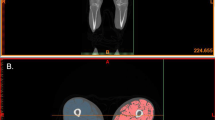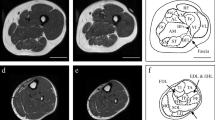Abstract
Purpose
Muscle atrophy is a commonly encountered problem in osteoarthritis (OA). The aim of this study was to estimate the amount of muscle atrophy and fatty degeneration of the lower leg muscles related to ankle OA by magnetic resonance imaging (MRI).
Methods
Twenty-one patients with unilateral ankle OA were included in this cohort study. Calf circumference of the affected and healthy lower leg was documented. The degree of OA was classified in conventional radiographs. The cross-sectional areas and fatty degeneration of the muscles of the lower leg were measured in bilateral MRI.
Results
We found a significantly reduced calf circumference of the affected vs. healthy leg (p = 0.016). MRI showed a significantly lower cross-sectional area of the entire lower leg musculature in OA (p = 0.013). Sub-analysis of muscle groups revealed that only the M. soleus had a significant cross-sectional area decrease (p < 0.01). All muscles showed a significant fatty degeneration (p < 0.01).
Conclusions
We conclude that unilateral ankle joint osteoarthritis leads to an overall lower leg muscle atrophy, but significant atrophy of the M. soleus. All muscles of the affected leg undergo a fatty degeneration.




Similar content being viewed by others
References
Centers for Disease Control and Prevention (CDC) (2010) Prevalence of doctor-diagnosed arthritis and arthritis-attributable activity limitation—United States, 2007–2009. MMWR Morb Mortal Wkly Rep 59(39):1261–1265
Kannus P, Palvanen M, Niemi S, Parkkari J, Jarvinen M (2002) Increasing number and incidence of low-trauma ankle fractures in elderly people: Finnish statistics during 1970–2000 and projections for the future. Bone 31(3):430–433
Valderrabano V, Horisberger M, Russell I, Dougall H, Hintermann B (2009) Etiology of ankle osteoarthritis. Clin Orthop Relat Res 467(7):1800–1806. doi:10.1007/s11999-008-0543-6
Valderrabano V, Hintermann B, Horisberger M, Fung TS (2006) Ligamentous posttraumatic ankle osteoarthritis. Am J Sports Med 34(4):612–620
Horisberger M, Valderrabano V, Hintermann B (2009) Posttraumatic ankle osteoarthritis after ankle-related fractures. J Orthop Trauma 23(1):60–67. doi:10.1097/BOT.0b013e31818915d9
Nuki G (1999) Osteoarthritis: a problem of joint failure. Z Rheumatol 58(3):142–147
Hunter DJ, Felson DT (2006) Osteoarthritis. BMJ 332(7542):639–642. doi:10.1136/bmj.332.7542.639
Kidd BL (2006) Osteoarthritis and joint pain. Pain 123(1–2):6–9. doi:10.1016/j.pain.2006.04.009
Hurley MV, Scott DL, Rees J, Newham DJ (1997) Sensorimotor changes and functional performance in patients with knee osteoarthritis. Ann Rheum Dis 56(11):641–648
Zacharova G, Knotkova-Urbancova H, Hnik P, Soukup T (1997) Nociceptive atrophy of the rat soleus muscle induced by bone fracture: a morphometric study. J Appl Physiol 82(2):552–557
Valderrabano V, von Tscharner V, Nigg BM, Hintermann B, Goepfert B, Fung TS, Frank CB, Herzog W (2006) Lower leg muscle atrophy in ankle osteoarthritis. J Orthop Res 24(12):2159–2169. doi:10.1002/jor.20261
Kitaoka HB, Alexander IJ, Adelaar RS, Nunley JA, Myerson MS, Sanders M (1994) Clinical rating systems for the ankle-hindfoot, midfoot, hallux, and lesser toes. Foot Ankle Int 15(7):349–353
Carlsson AM (1983) Assessment of chronic pain. I. Aspects of the reliability and validity of the visual analogue scale. Pain 16(1):87–101
Morrey BF, Wiedeman GP Jr (1980) Complications and long-term results of ankle arthrodeses following trauma. J Bone Joint Surg Am 62(5):777–784
Fuchs B, Weishaupt D, Zanetti M, Hodler J, Gerber C (1999) Fatty degeneration of the muscles of the rotator cuff: assessment by computed tomography versus magnetic resonance imaging. J Shoulder Elbow Surg 8(6):599–605
Zanetti M, Gerber C, Hodler J (1998) Quantitative assessment of the muscles of the rotator cuff with magnetic resonance imaging. Invest Radiol 33(3):163–170
Pap G, Machner A, Awiszus F (2004) Strength and voluntary activation of the quadriceps femoris muscle at different severities of osteoarthritic knee joint damage. J Orthop Res 22(1):96–103
Sirca A, Susec-Michieli M (1980) Selective type II fibre muscular atrophy in patients with osteoarthritis of the hip. J Neurol Sci 44(2–3):149–159
Slemenda C, Brandt KD, Heilman DK, Mazzuca S, Braunstein EM, Katz BP, Wolinsky FD (1997) Quadriceps weakness and osteoarthritis of the knee. Ann Intern Med 127(2):97–104
Nakamura T, Suzuki K (1992) Muscular changes in osteoarthritis of the hip and knee. Nihon Seikeigeka Gakkai Zasshi 66(5):467–475
Janda V (1983) Muscle function testing. Butterworths, London
Michael RH, Holder LE (1985) The soleus syndrome. A cause of medial tibial stress (shin splints). Am J Sports Med 13(2):87–94
Campbell KM, Biggs NL, Blanton PL, Lehr RP (1973) Electromyographic investigation of the relative activity among four components of the triceps surae. Am J Phys Med 52(1):30–41
Einsingbach T (1986) Funktionelle Behandlung be Knieinstabilitäten. In: Krankengymnastik Jg. 38. Heft 6:411–430
Arokoski MH, Arokoski JP, Haara M, Kankaanpaa M, Vesterinen M, Niemitukia LH, Helminen HJ (2002) Hip muscle strength and muscle cross sectional area in men with and without hip osteoarthritis. J Rheumatol 29(10):2185–2195
Rasch A, Bystrom AH, Dalen N, Berg HE (2007) Reduced muscle radiological density, cross-sectional area, and strength of major hip and knee muscles in 22 patients with hip osteoarthritis. Acta Orthop 78(4):505–510. doi:10.1080/17453670710014158
Hedtmann A, Heers G (2007) Imaging in evaluating rotator cuff tears. Orthopade 36(9):796–809. doi:10.1007/s00132-007-1138-8
Spencer EE Jr, Dunn WR, Wright RW, Wolf BR, Spindler KP, McCarty E, Ma CB, Jones G, Safran M, Holloway GB, Kuhn JE (2008) Interobserver agreement in the classification of rotator cuff tears using magnetic resonance imaging. Am J Sports Med 36(1):99–103. doi:10.1177/0363546507307504
Gladstone JN, Bishop JY, Lo IK, Flatow EL (2007) Fatty infiltration and atrophy of the rotator cuff do not improve after rotator cuff repair and correlate with poor functional outcome. Am J Sports Med 35(5):719–728. doi:10.1177/0363546506297539
Hintermann B, Valderrabano V, Knupp M, Horisberger M (2006) The HINTEGRA ankle: short- and mid-term results. Orthopade 35(5):533–545. doi:10.1007/s00132-006-0941-y
Valderrabano V, Pagenstert G, Horisberger M, Knupp M, Hintermann B (2006) Sports and recreation activity of ankle arthritis patients before and after total ankle replacement. Am J Sports Med 34(6):993–999
Valderrabano V, Hintermann B, Dick W (2004) Scandinavian total ankle replacement: a 3.7-year average followup of 65 patients. Clin Orthop Relat Res (424):47–56
Valderrabano V, Nigg BM, von Tscharner V, Frank CB, Hintermann B (2007) J. Leonard Goldner award 2006. Total ankle replacement in ankle osteoarthritis: an analysis of muscle rehabilitation. Foot Ankle Int 28(2):281–291
Acknowledgements
The authors want to thank Thomas Egloff and Thorsten Wischer for support in evaluation of the MRI images.
Author information
Authors and Affiliations
Corresponding author
Rights and permissions
About this article
Cite this article
Wiewiorski, M., Dopke, K., Steiger, C. et al. Muscular atrophy of the lower leg in unilateral post traumatic osteoarthritis of the ankle joint. International Orthopaedics (SICOT) 36, 2079–2085 (2012). https://doi.org/10.1007/s00264-012-1594-6
Received:
Accepted:
Published:
Issue Date:
DOI: https://doi.org/10.1007/s00264-012-1594-6




